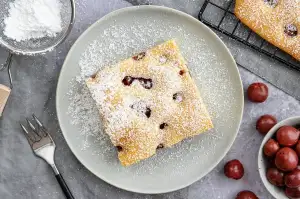Master the Art of Cleaning a Cast Iron Pan: A Step-by-Step Guide for a Spotless Home Kitchen

- Gather the necessary supplies for cleaning
- Step-by-step instructions for cleaning a cast iron pan:
- Allow the pan to cool down completely
- Use a stiff brush or sponge to remove any food residue
- Rinse the pan with hot water
- Dry the pan thoroughly
- Apply a thin layer of oil to the pan
- Store the pan in a dry place
- Tips for maintaining the quality of your cast iron pan
Cleaning a cast iron pan is not just about maintaining its appearance, but also ensuring its longevity and performance in the kitchen. A well-cleaned cast iron pan will not only cook food evenly but also develop a natural non-stick surface over time. Neglecting proper cleaning can lead to rust, food sticking, and even a metallic taste in your dishes. In this step-by-step guide, we will show you how to master the art of cleaning a cast iron pan, so you can enjoy spotless cooking experiences and preserve the quality of your beloved kitchen tool.
Gather the necessary supplies for cleaning
To properly clean a cast iron pan, it is essential to gather the necessary supplies. Here's what you'll need:
1. Stiff brush or sponge: Look for a brush with firm bristles or a sponge with an abrasive side to effectively remove any food residue without damaging the pan's surface.
2. Hot water: Make sure to have access to hot water as it helps in loosening stubborn food particles and aids in the cleaning process.
3. Dish soap (optional): While some prefer not to use dish soap on cast iron pans, a mild dish soap can be used sparingly if needed. Ensure that it does not contain harsh chemicals that can strip away the pan's seasoning.
4. Paper towels or clean cloth: These will be used for drying the pan thoroughly after washing.
5. Cooking oil: Choose a high smoke point oil like vegetable oil or flaxseed oil for seasoning the pan after cleaning.
By having these supplies ready, you'll be well-prepared to clean your cast iron pan effectively and maintain its longevity.
Step-by-step instructions for cleaning a cast iron pan:
a. Allow the pan to cool down completely
b. Use a stiff brush or sponge to remove any food residue
c. Rinse the pan with hot water
d. Dry the pan thoroughly
e. Apply a thin layer of oil to the pan
f. Store the pan in a dry place
Allow the pan to cool down completely
Allowing the cast iron pan to cool down completely is an essential step in the cleaning process. It is important to let the pan cool naturally, as placing it under cold water while it is still hot can cause it to warp or crack. Patience is key here, as rushing this step can lead to irreversible damage. So, resist the temptation to speed up the cooling process and give your cast iron pan the time it needs to cool down completely.
Use a stiff brush or sponge to remove any food residue
To remove any food residue from your cast iron pan, use a stiff brush or sponge. Gently scrub the surface of the pan, making sure to reach all the corners and crevices. The bristles of the brush will help loosen any stuck-on food particles without damaging the seasoning of the pan. If there are stubborn stains, you can also use a small amount of coarse salt as an abrasive. Remember to be gentle yet thorough in your cleaning process to ensure a spotless finish.
Rinse the pan with hot water
After using a stiff brush or sponge to remove any food residue from your cast iron pan, the next step is to rinse it with hot water. This will help to remove any remaining debris and ensure that the pan is clean. Make sure the water is hot enough to effectively wash away any grease or oil that may be clinging to the surface of the pan. Use your hands or a cloth to scrub the pan gently while rinsing it under the hot water. Be thorough in your rinsing, making sure to cover all areas of the pan, including the handle and sides. Once you have thoroughly rinsed the pan, you can move on to drying it.
Dry the pan thoroughly
After rinsing the pan with hot water, it is crucial to dry it thoroughly. Leaving any moisture on the surface can lead to rusting and damage the seasoning of your cast iron pan. To dry the pan, use a clean kitchen towel or paper towels to absorb any remaining water. Make sure to wipe both the interior and exterior of the pan until it is completely dry. If needed, you can also place the pan on low heat for a few minutes to evaporate any lingering moisture. Remember, a well-dried cast iron pan will ensure its longevity and prevent any unwanted rust formation.
Apply a thin layer of oil to the pan
To ensure the longevity and performance of your cast iron pan, it is crucial to apply a thin layer of oil after each cleaning. This step helps to prevent rust and maintain its non-stick surface. Once the pan is dry, pour a small amount of vegetable oil or melted shortening onto a paper towel. Rub the oil all over the interior and exterior of the pan, making sure to cover every inch. This will create a protective barrier against moisture and keep your pan in top condition. Remember, less is more when it comes to oiling – you only need a thin coating.
Store the pan in a dry place
Once you have thoroughly cleaned and dried your cast iron pan, it is important to store it in a dry place. Moisture can cause the pan to rust, which can ruin its quality and affect its cooking performance. Avoid storing the pan in a humid environment, such as under the sink or near a dishwasher. Instead, find a cool and dry spot in your kitchen where the pan can be stored safely. You can also place a paper towel or cloth between pans if you stack them to prevent any moisture buildup. By storing your cast iron pan properly, you ensure that it stays in excellent condition for years to come.
Tips for maintaining the quality of your cast iron pan
1. Avoid using soap: Soap can strip away the seasoning of your cast iron pan, so it's best to avoid using it. Instead, rely on hot water and a brush or sponge to clean off any residue.
2. Dry thoroughly: After washing your cast iron pan, make sure to dry it thoroughly. Any leftover moisture can lead to rusting. You can even place it on a low heat burner for a few minutes to ensure complete drying.
3. Re-season periodically: Over time, the seasoning on your cast iron pan may wear off. To maintain its non-stick surface, re-season it by applying a thin layer of oil and baking it in the oven at a low temperature for about an hour.
4. Avoid drastic temperature changes: Rapid changes in temperature can cause your cast iron pan to warp or crack. Always allow it to cool down before cleaning or placing it under cold water.
5. Use wooden or silicone utensils: Metal utensils can scratch the surface of your cast iron pan and damage its seasoning. Opt for wooden or silicone utensils instead to preserve its quality.
By following these tips, you can ensure that your cast iron pan remains in excellent condition for years to come, providing you with delicious meals and lasting culinary memories.
By following these step-by-step instructions for cleaning your cast iron pan, you can ensure its longevity and enjoy its many benefits. A properly cleaned and maintained cast iron pan will provide you with even heat distribution, excellent searing capabilities, and enhanced flavor in your dishes.
Not only does a clean cast iron pan enhance your cooking experience, but it also promotes good hygiene in your kitchen. By removing any food residue and applying a thin layer of oil after each use, you can prevent rust and maintain the non-stick surface of your pan.
So, take the time to master the art of cleaning your cast iron pan. With proper care, it will become a reliable tool in your kitchen arsenal, allowing you to create delicious meals for years to come. Embrace the beauty of a spotless home kitchen and savor the delights that come from using a well-maintained cast iron pan.
Published: 04. 02. 2024
Category: Food



